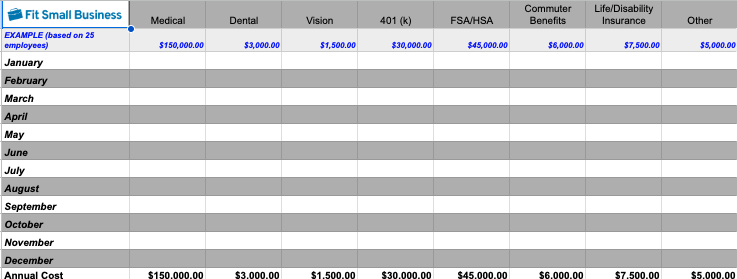Knowing how to offer employee benefits can help you attract and retain top talent within your industry. Providing benefits to employees requires you to establish your budget, identify the benefits you want to include, and consider how you want the benefits managed (i.e., through a professional employer organization) before finalizing and rolling out the plan.
Step 1: Set Up a Budget
The first step in any business decision is to determine the budget available. Regardless of the types of benefits you provide, you’ll need to decide how much your small business can contribute toward a comprehensive employee benefits package. The least expensive are one-time items, such as a company T-shirt or a lunch-and-learn series. The most expensive (and frequently most valuable to employees) are health-related benefits, like medical insurance, and long-term savings plans, like a 401(k).
Essentially, this is a needs assessment—based on what the company can afford and the standard benefit offerings from employers. Many benefits are available as pre-tax options, lowering an employee’s overall taxable income. You can download the employee benefits program budget template below and customize it to meet your benefits needs for an easy time assessing your budget.
Cost Analysis per Benefit
It’s important to do a cost analysis per benefit when determining your budget. Recently released data from the Bureau of Labor Statistics shows the various amounts that employers pay for different kinds of employee benefits. The percentage that employers spend is around 29.6% of each employee’s total compensation. For example, for an employee making $35 per hour, the average employer pays an additional $14.76 per hour in employee benefits.
Employee Benefits | How It Works | Monthly Cost per Covered Employee |
|---|---|---|
Health Insurance | Employers typically share costs with employees, such as 50/50, or up to a specific dollar amount. | $500 and up |
Dental Insurance | Employers may contribute, or employees pay full premiums. | $10–$25 average |
Vision Insurance | Employers may contribute, or employees pay full premiums. | $5–$10 average |
FSA and HSA Savings Accounts | Either employer or employee can contribute; subject to annual limits. | $50–$200 is common |
Retirement Planning | Employers typically contribute a dollar amount or percent, e.g., matching 2%-5% of earnings | Varies based on rates and earnings |
Commuter Benefits | Employees are reimbursed for commuter expenses; required in some locations. | $20-$255; varies |
Life and Disability Insurance | Some employers pay for a fixed benefit amount, such as $50,000, providing an option for employees to purchase additional coverage. | $25-$35; varies |
Step 2: Decide Which Benefits to Include in Your Program
At this stage in planning, small businesses should decide which benefits to include in their employee benefits package. There are many different benefits employers can offer to their employees. Below is a list of popular options when setting up benefits for employees:
- Medical/Dental/Vision: Many employers contribute to the medical portion of this program (for instance, 50/50) while keeping dental and vision employee-paid only. Keeping the program affordable will likely increase employee participation.
- Paid time off (vacation days, sick days, and holidays): Having a robust PTO policy creates a good work/life balance. Employees need time to disconnect from work and focus on their personal life. A progressive PTO package can produce a better-quality work environment and increase production. Here’s a guide to creating a PTO policy—but for the best work/life balance, I recommend creating an unlimited PTO policy.
- Retirement savings options, e.g., 401(k) or 403(b): 401(k) plans are a good option as the employee can save a certain amount per year. Many companies also have 401(k) matching, meaning the company will match employee contributions up to a certain percentage (usually a 5% cap). For options, check out our best 401k companies guide.
- Flexible or health savings accounts (FSAs or HSAs): FSA and HSA accounts help employees with out-of-pocket medical expenses. The employee contributes a certain amount per year, and sometimes the company will also contribute (typically up to 5%).
- Life insurance/disability insurance: This is a good option for employees to help with expenses (medical, funeral, etc.). It can be company-sponsored and/or employee-contributed.
- Additional work/life balance perks: Options can include flexible work schedule policies, remote work, professional development, employee clubs/activities/gifts, food/beverage, etc.
Most of the benefits on this list fall under pre-tax deductions. Check out our guide to learn which benefits are pre-tax and post-tax deductions, which can help reduce your overall tax obligations.
Reminder: Certain benefits may be required by law and include:
- Social Security
- Medicare
- Unemployment insurance
- Workers’ compensation (required in all 50 states, except Texas)
- COBRA
- Short-term disability insurance (required in California, Hawaii, New Jersey, New York, Rhode Island, and Puerto Rico)
- Leaves of absence (paid FMLA required in California, Colorado, Connecticut, Delaware, Hawaii, Maine, Massachusetts, Maryland, New Jersey, New York, Oregon, Rhode Island, Washington, Washington, D.C., and Puerto Rico)
- Disability leave (paid FMLA required in California, Colorado, Connecticut, Delaware, Hawaii, Maine, Massachusetts, Maryland, New Jersey, New York, Oregon, Rhode Island, Washington, Washington, D.C., and Puerto Rico)
- Paid maternity leave and/or paternity leave (required in California, Colorado, Washington, D.C., Kansas, Maryland, New Jersey, New York, Oregon, Virginia, and Washington)
Although not all businesses offer the benefits noted below, there is competition among companies to be creative, dynamic, and flexible with employee benefits packages. Not all companies want “dog-friendly” workplaces or can offer free lunches every day, but there are creative ideas your employees will love that may fit with your benefits philosophy.
Some less common benefits (or perks) that you may want to consider are:
- Free snacks or beverages in the workplace
- Free gym memberships or on-site gym
- Student loan or tuition assistance
- Company-wide retreats
- Free or low-cost daycare services
- Company-paid stipend to use for vacation
- Remote work options
- Unlimited PTO
- Team bonding events
- Pet-friendly workplaces
When deciding what benefits you want to offer, it is important to consider how they fit with your employees’ total compensation. Total compensation includes all forms of pay and monetized benefits, including those mentioned above as well as the examples listed below:
- Bonuses
- Commissions
- Profit-sharing distributions
- Tuition assistance
- Child care assistance
- Public transit credits or reimbursements (commuter benefits)
- IT reimbursements (home Wi-Fi, cellphone, personal computer, etc.)
- Gym or club memberships
- Employee assistance programs (EAP)
Step 3: Consider External Resources
Creating a comprehensive employee benefits package can be stressful. To help alleviate some of the headaches and make sure HR laws are followed, consider using an external resource for your benefits program.
- Professional employer organizations (PEOs) manage all aspects of HR administration and provide access to group benefit rates small businesses wouldn’t otherwise qualify for.
- An employer of record (EOR) takes financial and legal responsibility for employees, handling onboarding, payroll, and benefits administration.
- Administrative services organizations (ASOs) provide administrative and HR services to your business, including simple and complex HR tasks, training, recruitment, payroll, and benefits administration.
- A human resources information system (HRIS) centralizes employee information, including applicant tracking, benefits administration, performance management, and payroll.
Step 4: Finalize Your Benefits Program
Now that you have created your budget and identified which benefits to include in your package, it is time to finalize your plan before rolling it out to employees. I recommend talking with healthcare providers to determine the best plan for your company. Be advised, however, that benefits plans can be complex, and there are many different options to consider.
Once you decide which plan you will offer to your employees, you will need to gather the paperwork required by the provider, sign them, and determine the start date of your plan. This step should be followed for each type of benefit you provide to your employees.
For most small businesses, trying to piece together the confusing selection of benefits programs into one package can be daunting. Rippling brings all benefits—health insurance, 401(k), commuter, and more—into one system and automates the busy work, like enrolling new hires, updating deductions, and administering COBRA. Read our Rippling review to learn more about it.
Determine Who Is Eligible for Employee Benefits
If you are an applicable large employer, you must follow minimum benefit eligibility requirements for your employees under the Affordable Care Act (ACA). Beyond that, most companies base eligibility on the number of hours worked.
For example, a full-time employee who works 40 hours per week would automatically be eligible for benefits coverage. However, a part-time employee, who only works 20 hours per week, may not be eligible. You will be responsible for determining the criteria for who is eligible and who is not.
I recommend limiting certain benefits, such as healthcare coverage and retirement benefits, to only those employees who are considered full-time employees. Other benefits, such as paid time off and life insurance, could be offered to all employees, including part-time. However, if you offer paid time off to part-time employees, I would limit the number of hours available. Full-time employees should receive more.
Step 5: Roll Out the Plan to Employees
Once your program is established, eligibility has been determined, paperwork has been signed with benefits providers, and you are ready to incorporate your benefits package into the employee experience, communicating what has been developed, as well as how and why, is essential.
I recommend following these steps for implementing an effective communication campaign for your employee benefits program:
- Notify your employees. Hold a group discussion meeting to deliver the details of the benefits program to your employees and answer any questions. Be enthusiastic about your program, and your employees will be as well.
- Provide details of the plan. You should provide your employees with physical or digital copies of each benefit available, including the cost to the employee and the amount the company will contribute.
- Double-check for understanding. Once the news has been shared, ensure an adequate follow-up to see if everyone understands their benefits, coverages, how dependents may be covered, etc.
- Utilize a portal or online resource. Once you have shared the news and launched your benefits program, publish it. Make sure that employees have a place to return to get additional questions answered and independently learn more about what and how their benefits can enhance their quality of life.
- Update your company’s career page. Potential employees are becoming savvier as they research companies online. As job candidates and casual job seekers check out your careers page, you will want to ensure that your top benefits are listed and easy to understand.
- Mention benefits in your job advertisements. Although job advertisements are primarily about the job you want to fill, always include a brief yet informative blurb about your benefits. It is what attracts job seekers.
Why Offering Benefits Packages Is Important
Employers who invest in their employees’ well-being have happier, more productive workers. Adequate health coverage, retirement plans, and vacation time can help create a better work-life balance for employees, leading to improved mental health and overall job satisfaction.
When developing your employee benefits package, it is essential to consider how employees look at benefits. Take a look at the breakdown below of the importance of each benefit to both employees and employers. I’ve arranged the table by importance to employees.
Benefit | Employees | Employers |
|---|---|---|
Flexible Work Arrangements | 19% | 13% |
Health Benefits | 16% | 25% |
Retirement Plan | 14% | 6% |
Financial Wellbeing | 11% | 5% |
Family and Caregiving Support | 8% | 4% |
Mental Health Support | 7% | 15% |
Insurance Benefits | 7% | 13% |
Inclusion and Diversity | 5% | 11% |
(Source: WTW: 2024 Global Benefits Attitudes Survey)
Tips to Follow When Developing Your Employee Benefits Program
There can be a divide between what employees and employers think about benefits—as you can see from the table above. As you work to narrow this gap in your workplace, keep these three guiding principles in mind:
- Start slow; there is no going back. Once you offer new benefits, taking them away (due to expense or other factors) is not an enjoyable endeavor. Employees do not like having access to a benefit one minute and then losing it, regardless of the reason, the next.
- Assess the actual cost of each benefit. Many employers will cling to an idea for a new benefit and expose employees to it without first knowing the true costs of the benefit. That is, how much will this benefit cost the company if all eligible employees sign up? Will there be administrative upkeep for the benefit?
- Don’t just look at what others are doing. Although this is a wise action to take, do not let this be your only vetting method. Ensure that your benefits are supported by your team so they serve your employees’ unique needs and desires in the best way possible.
Research Data on Your Employee Demographics
There are countless ways to determine how and what employee benefits you want to offer to your team members, including researching what other companies are doing and looking at benefits surveys. The most straightforward ways to view benefits are the ones that point to the most popular benefits for employees.
Survey Employees for Benefits Ideas
Surveying your employees is the quickest way to clearly understand what they are excited about in terms of employee benefits and their total compensation. Surveys can be shared in several ways, but their true attraction is the fact that employers receive valuable feedback from employees about what they want to see more of, and employees can share their honest thoughts, feelings, and ideas anonymously.
The two most common ways of surveying employees we found to be effective are:
- Hosting employee surveys in-house, often led by HR.
- Utilizing a third-party surveyor to execute the survey for your organization. You can customize your survey questions and then launch them online for employees to participate anonymously. For some options, check our guide to the best employee survey tools.
Employee Benefits Frequently Asked Questions (FAQs)
You can contact a provider personally to secure benefits, such as healthcare, life insurance, and dental/vision. However, to save time and resources, I recommend using a payroll or HR services provider that can source these benefits for you. Plus, they often have access to more benefit options at competitive prices compared to what you can find on your own.
Employees want comprehensive healthcare options, as well as paid time off and flexible working arrangements. Make sure these elements, along with sick/holiday leave, insurance options, and retirement benefits are part of your inclusive benefits package.
Only after you create your budget, determine the type of benefits you will offer, and contact providers, conduct an information meeting with employees to explain the benefits and what, if any, contribution will be required by the employee. You will want to have all materials ready that show benefits types, what is included in plans, and the total cost involved.
The simple answer is yes. Employee benefit deductions are subtracted before tax withholdings and are calculated on the employee’s paycheck (reducing the company’s payroll tax liability).
If your business has employees and you pay health insurance premiums for them, these amounts are deducted on the applicable tax form and line for employee benefit program expenses. For example, if your business is a sole proprietorship, you deduct premiums paid to provide health coverage to employees on Schedule C.



